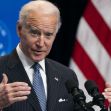Stressing diversity and inclusivity, President Biden reversed the Trump administration’s ban on transgender individuals serving in the military. “It is my conviction as Commander in Chief of the Armed Forces,” he said, “that gender identity should not be a bar to military service,” and he asked his new Secretary of Defense to make it happen.
The January 25 order stated, “It shall be the policy of the United States to ensure that all transgender individuals who wish to serve in the United States military and can meet the appropriate standards shall be able to do so openly and free from discrimination.”
In signing his “Executive Order on Enabling All Qualified Americans to Serve Their Country in Uniform,” Biden decried the previous administration’s decision to alter the Obama administration’s 2016 decision to permit transgender individuals to openly serve. He described a “meticulous, comprehensive study” by the Department of Defense that found transgender military service would only have minimal impacts on military readiness, foreign unit cohesion and healthcare costs.
Then he berated Trump for failing to honor that study. “Rather than relying on the comprehensive study by a nonpartisan federally funded research center, the previous administration relied on a review that resulted in a policy that set unnecessary barriers to military service,” Biden’s order stated.
The Pentagon has not released statistics that show how many members of U.S. armed forces have left since Trump’s order took effect in 2019.
Under President Trump, the Defense Department permitted service by transgender personnel in only three cases; if they had not been diagnosed with gender dysphoria, the psychological condition that results when the sex assigned at birth is not the same as one’s gender identity; if they had not transitioned to a different sex; and if they could meet all standards for their biological gender, including uniforms and grooming.
Biden’s new Executive Order revokes both the Presidential Memorandum of March 23, 2018 and the Presidential Memorandum of August 25, 2017, regarding Military Service by Transgender Individuals. It also keeps one of Biden’s campaign promises that pledged he would establish more inclusive rules for military service.
The order, estimated by activists to impact about 15,000 service personnel, explained that our all-volunteer armed services thrive when those who meet the “rigorous standards” for military service are allowed to serve because their inclusion “strengthens our national security.” It also offered more up-to-date evidence that came from Congressional testimony by Army, Navy and Air Force chiefs. In 2018, all three branches told members of Congress that they were “not aware of any disciplinary, morale or unit cohesion issues” that arose from military service by open transgenders.
Their findings were echoed by a group of Surgeons General who had served in administrations headed by both parties. They found that both transgender and non-transgender military personnel had the same level of medical fitness and that there was no medically valid reason to exclude them.
The January 25 order directs the Secretary of Defense and the Secretary of Homeland Security to consult with the Joint Chiefs of Staff about the best way to implement the new order. It also asks them to create a process by which transgender service members may transition while serving, a procedure that was also found appropriate in the 2016 study.
It then outlined a series of steps for the Secretary of Defense to take. These include: immediately prohibiting involuntary discrimination on the basis of gender identity; identifying and examining the records of any individuals who might have involuntarily separated; issuing guidance to all branches of the military to correct the military records of those who might have been affected; taking steps necessary to remove injustice; and offering opportunities to rejoin. The Secretary of Homeland Security was asked to take similar steps regarding the Coast Guard, which is under his jurisdiction.
During the Presidential campaign, Biden said he would take steps to enact many positive policies on LGBTQ issues. He has already issued an executive order protecting against discrimination in schools, health care, employment and other areas of life. In addition, Rachel Levine, his new assistant secretary of health, is the first openly transgender official in the federal government who was even confirmed by the U.S. Senate.
After he put his signature on the new order, Biden joked he would then be attending the swearing-in ceremony of Lloyd Austin, the new Secretary of Defense, who had stated that he supported the repeal during his confirmation hearings. “And so, don’t say anything to cause him to change his mind, okay?”
And with that stroke of his pen, the new President ends what Shannon Minter, legal director of the National Center for Lesbian Rights told The New York Times was, “one of the most serious threats to the legal equality of transgender people in our nation’s history.”






